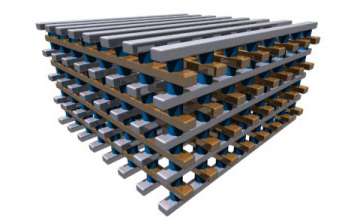Right now there are two technologies that are poised to answer these demands in the near future. One of them is based on a new twist of an existing technology and the other branches off and forges a new path. The first of these has been presented by one of the leaders in flash technology, Samsung. They are showing off a new 3D version of your typical NAND Flash product. The concept is simple really, you stack the NAND cells one on top of the other instead of laying them out side-by-side. If the concept is simple the implementation is not. Samsung had to develop a new interconnect that would allow data to pass between the layers of NAND cells as well as between the stack and the controller. This is proprietary to them right now although it might end up as an SEP (Standards Essential Patent) in the future if this new twist on Flash passed validation at the manufacturer end.
According to Samsung the new 3D NAND should double the speed of current modules and will make them roughly ten times more durable. You can also expect the capacities to ramp up nicely with 128GB and 1TB modules to be in the mix very early on. Right now Samsung expects to drop these new modules into enterprise class storage by end of year to be followed up by mobile products in early to mid-2014.
Now a 200% improvement in performance is pretty big, but what if someone came along and told you about a technology that offers a 1,000% performance increase? That is what newcomer Crossbar is looking to bring to the table with their implementation of Resistive Random Access Memory (RRAM) technology. This technology also implements stacks of modules rather than putting them side-by-side, but the performance is greater than what you can get with stacking NAND. According to Crossbar the performance would be 10 times the level of current NAND and 20 time lower power consumption in performing the same tasks. The capacity is about the same as the stacked NAND modules with 128GB and 1TB modules easily produced (due to the stacked nature).
Unfortunately there is no timeline on when Crossbar might make it into devices. Right now they have just validated manufacturing of this type of device using standard manufacturing processes. It is a big step toward production, but they are not near that goal yet. Crossbar and their 20 employees are not sitting still though, they are working on getting more funding so they can push forward with development and eventual production.
Between these two technologies you are much more likely to be buying stacked NAND in the next few years than you are Crossbar RRAM. This is simple logistics, Samsung has the money and production facilities to get this out to the public (and put in their own devices) while Crossbar is trying to bring a new product to an old game where all of the major players are holding the good cards. It is likely that someone will gobble up Crossbar and their 30 patents (with 70 more in the pipe) and make this an exclusive technology. The two likely candidates for this would be Samsung and Apple. Both have a stake in the mobile market and Samsung has a big one in the Flash market. So now that it looks like the Storage bottle neck will be sorted in the next few years, we wonder where the next performance roadblock will appear…. You can drop your two cents on this in our Forum

